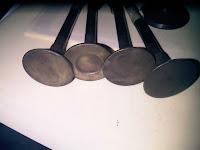Well, nothing much has happened in the "restore" mode of the car. I wanted to have the motor completed before the end of Christmas break, but there have been some major setbacks.
I finished the heads and started seating the new valves when I noticed one of the valves was very loose in the seat. (This is the valve that had the broken spring back sometime in the early 90's.) The valve seats way too low in the head. There is a half-inch play in the valve as well.

 My choices were to replace the head, put in new valve sleeves and hope they fix the problem, use oversized valves, or just send the heads out and have them completely redone. I decided on none of the above. After researching the block a little further, I found out it is actually a 1967 428ci Cobra Jet block. This led me to hunt for a new motor as a basic build.
My choices were to replace the head, put in new valve sleeves and hope they fix the problem, use oversized valves, or just send the heads out and have them completely redone. I decided on none of the above. After researching the block a little further, I found out it is actually a 1967 428ci Cobra Jet block. This led me to hunt for a new motor as a basic build.Luckily, I was able to acquire a new 390 today. I have not picked it up yet, but I have purchased it and secured it. The only information on the history if it is that it is from a 1969 car and has a 2bl carb. The engine comes complete with carb, automatic tranny, starter, alternator, and original stock powered by ford chrome covers still attached. ($200 for everything) I was unable to get any block numbers, but the block does have lower ribs, which indicates it was probably a 427 interceptor base block. I will not know much more until I get it home and start the process of taking it apart.
Since I already have all of the parts to rebuild my 390, this should be an easy rebuild. I will be using my original intake manifold in place of the 2bl intake.
















































